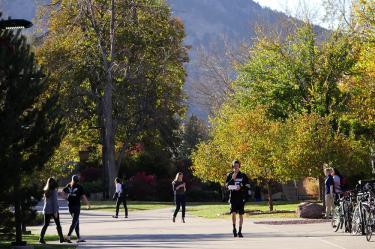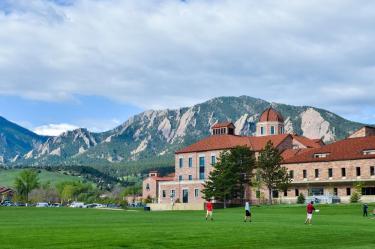Colorado economy growing but slowing in 2019, according to forecast
Key Takeaways:
- The Colorado economy is projected to add more than 53,200 jobs (2 percent) in 2019, according to the latest Colorado Business Economic Outlook.
- The Professional and Business Services sector will add the most jobs, driven by the technology industry.
- The Western Slope and Colorado Springs will be the biggest regional winners.
Media Kit:
- Download the 2019 Colorado Business Economic Outlook
- Find more story ideas at CU Boulder Today
The Colorado economy is growing, but the Colorado Business Economic Outlook (CBEO) projects a slower pace in 2019.
The yearly forecast is compiled by the Business Research Division in the Leeds School of Business at the University of Colorado Boulder. It is the most comprehensive annual outlook on the Colorado economy, breaking down 13 business sectors and seven regions around the state.
It will be presented to state business leaders at the 54th annual Colorado Business Economic Outlook Forum Monday. You can follow or join the conversation on social media via #COBizOutlook.
This year’s outlook forecasts Colorado will add about 53,200 jobs in 2019, a growth rate of 2 percent. That marks 11,800 fewer jobs than the state added in 2018.
“This is still a strong growth rate,” said Richard Wobbekind, executive director of the Leeds Business Research Division. “But with a very low unemployment rate, it is hard to keep growing.”
While Colorado is competitive in attracting, recruiting and retaining talent, the CBEO notes population growth is projected to slow somewhat in 2019. The State Demography Office projects a net in-migration of 50,000 people.
Housing costs will continue to be an issue, Wobbekind said, as the supply of new homes slows in 2019.
Infrastructure and general construction will keep chasing the state’s growth, with the value of construction reaching a record $21.6 billion next year.
The report anticipates commodity prices will negatively affect certain industries like agriculture and energy.
This year’s forecast is encouraging, according to Wobbekind, in that the projected growth is across nearly every industry and region of the state.
AROUND THE STATE
Boulder County (page 120 in CBEO): Boulder County continues to outperform the state and national economies in job growth, educational attainment and capital investments. High-tech industries like aerospace are pushing higher than the state’s average wages. The outlook remains positive for 2019.
Kit Carson County (page 122 in CBEO): The county’s economy is mixed, with some businesses reporting a good year in 2018, while others struggle against the tides of e-commerce, rising minimum wages and agriculture woes. Kit Carson’s bright spot continues to be tourism.
La Plata County (page 123 in CBEO): Business owners are talking about cautious optimism in the area around Durango. The outlook estimates demand for construction, manufacturing and health services will continue to be solid in 2019. Concerns include low wages for entry-level workers, a high suicide rate, rising poverty and a declining tax base.
Mesa County (page 124 in CBEO): The outlook for Mesa County continues upward in 2019. With growing investments in energy, health care, aerospace and other sectors, the region is enjoying historically low unemployment. There are also unique development opportunities with several business park projects underway.
Northern Colorado (page 127 in CBEO): This area continues to grow in sectors from manufacturing to food services and continues to have some of the fastest growing metropolitan areas in the country.
Pueblo County (page 128 in CBEO): The area around Pueblo is seeing success recruiting high-tech companies. The Historic Arkansas Riverwalk Project will continue to support a growing city center.
Southern Colorado (page 129 in CBEO): The Colorado Springs recovery was delayed, but it is delayed no more. Real estate is outpacing the nation. Employment is climbing. High-paying industry sectors are on the rise.
KEY INDUSTRY 2019 FORECAST
Industry | Job growth | Change from 2018 |
Construction | 5,000 | 2.9 percent |
Education and health services | 6,500 | 1.9 percent |
Financial activities | 1,700 | 1.0 percent |
Government | 6,700 | 1.5 percent |
Information | 1,400 | 1.9 percent |
Leisure and hospitality | 7,500 | 2.2 percent |
Manufacturing | 1,700 | 1.2 percent |
Natural resources and mining | 1,400 | 4.8 percent |
Professional and business services | 11,300 | 2.7 percent |
Trade, transportation and utilities | 8,700 | 1.8 percent |
Other services | 1,300 | 1.2 percent |
The current conditions and forecasts of the following industries are included in the Colorado Business Economic Outlook. Please reference the report for full discussion of trends and description of each industry sector.
Agriculture (page 16): Cattle, grain, hay, dairy, fruits and vegetables, nursery and floriculture.
Natural resources and mining (page 21): Oil and gas, minerals and uranium, renewables, wind energy, solar energy, hydroelectric power and geothermal energy.
Construction (page 31): Residential, nonresidential building and nonbuilding (infrastructure).
Manufacturing (page 36): Nondurable goods and durable goods, with a breakout section on cannabis.
Trade, transportation and utilities (page 43): Wholesale and retail trade, warehousing and air travel and utilities.
Information (page 50): Publishing (newspaper, books, directories and software), telecommunications, film, television and media.
Financial activities (page 59): Finance, insurance, real estate, rental and leasing.
Professional and business services (page 73; includes county breakdown): Professional, scientific and technical services; management of companies; and waste management and remediation services.
Education and health services (page 81): Private sector education services and health care, with sections on opioid addiction, county breakdowns on drug overdose deaths and health insurance coverage analysis across the state.
Leisure and hospitality (page 91): National and statewide tourism trends, hotel supply, casinos, restaurants, parks and outdoor recreation.
Other services (page 103): Includes trend overviews for 16,000 other businesses not well defined in other sectors, including religious, grantmaking, civic and professional organizations.
Government (page 104): Includes federal, state and local budget and tax projections and analysis.
International trade (page 111): Includes analysis of tariffs and macroeconomic factors.







